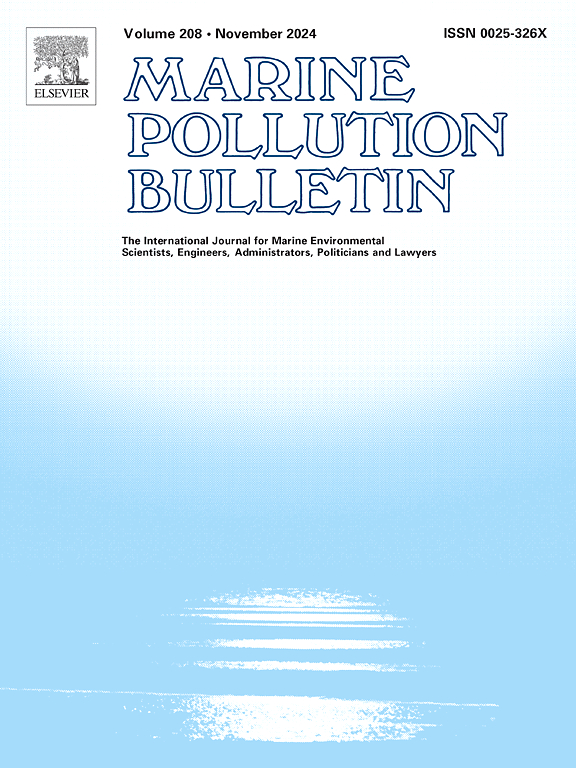Ulva生长的多情景模型支持台湾中西部沿海平原牡蛎养殖的风险管理
IF 4.9
3区 环境科学与生态学
Q1 ENVIRONMENTAL SCIENCES
引用次数: 0
摘要
摘要台湾中西部滨海湿地爆发巨藻Ulva,造成大量牡蛎产量损失。这一事件突出表明,在实时指标和应对战略方面存在重大差距,无法立即或有准备地减轻这种生态干扰。因此,我们的目标是将风险评估与数学模型相结合,量化营养物质排放、环境因素变化和潜在干预措施对养殖牡蛎Ulva覆盖相关死亡率的影响。通过对湿地及其附近排水系统的水质监测,为模拟不同环境条件下的大型藻类生物量提供依据。通过效应分析,为Ulva覆盖养殖牡蛎死亡风险商数的评价提供依据。春夏季牡蛎养殖场和排水水体中铵态氮、硝态氮和磷酸盐含量较高。模拟结果表明,如果牡蛎架周围捕获的Ulva比例从0.7增加到0.9,当外部系统中的Ulva生物量分别达到8和2 g干重(gDW) L−1时,将存在显著风险。研究还发现,与铵态氮、硝态氮和海水表面温度变化相比,外部系统输送的Ulva和牡蛎架周围滞留Ulva的可能性对风险更敏感。总体而言,我们基于风险的方法不仅可以确定Ulva覆盖导致养殖牡蛎死亡风险的关键因素,而且可以为海洋环境管理部门提供预警策略并采取有效干预措施以维持海洋水产养殖。本文章由计算机程序翻译,如有差异,请以英文原文为准。

Multi-scenario modeling of the Ulva growth supports risk management for oyster farming on a coastal flat in western central Taiwan
An outbreak of macroalgae Ulva caused massive oyster production losses in the coastal wetlands of western central Taiwan. This event highlighted a critical gap in real-time indicators and response strategies to immediately or preparedly mitigate such ecological disturbances. Therefore, we aim to integrate risk assessment with mathematical modeling to quantify the impacts of nutrients discharges, changes in environmental factors, and potential interventions on Ulva coverage-related mortalities of cultured oysters. We monitored water quality in the wetland and nearby drainages to provide a basis for simulating the macroalgae biomass under varying environmental conditions. Effect analysis was conducted to support assessing the risk quotients for the mortality of cultured oyster covered by Ulva. Higher concentrations of ammonium nitrogen, nitrate nitrogen, and phosphates in the water of oyster farms and drainages were detected during spring and summer. Simulation results showed that if the proportion of Ulva trapped around oyster racks increased from 0.7 to 0.9, there would be significant risks when Ulva biomass in the external system attains 8 and 2 g dry weight (gDW) L−1, respectively. We also found that Ulva transported from external systems and the likelihood of Ulva trapped around oyster racks were more sensitive to the risks than ammonium nitrogen, nitrate nitrogen, and changes in surface seawater temperature. Overall, our risk-based approach not only could identify crucial factors on the mortality risk of cultured oysters due to Ulva coverage, but also could inform marine environmental management to initiate early warning strategies and adopt effective interventions to sustain marine aquaculture.
求助全文
通过发布文献求助,成功后即可免费获取论文全文。
去求助
来源期刊

Marine pollution bulletin
环境科学-海洋与淡水生物学
CiteScore
10.20
自引率
15.50%
发文量
1077
审稿时长
68 days
期刊介绍:
Marine Pollution Bulletin is concerned with the rational use of maritime and marine resources in estuaries, the seas and oceans, as well as with documenting marine pollution and introducing new forms of measurement and analysis. A wide range of topics are discussed as news, comment, reviews and research reports, not only on effluent disposal and pollution control, but also on the management, economic aspects and protection of the marine environment in general.
 求助内容:
求助内容: 应助结果提醒方式:
应助结果提醒方式:


